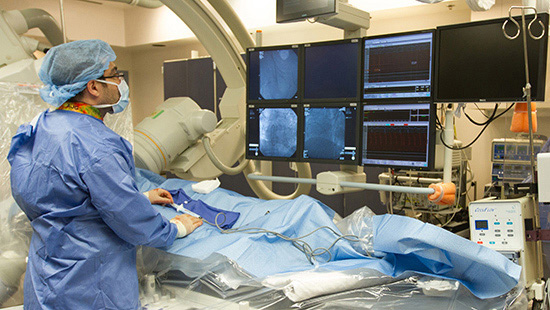AFib Stroke Prevention

Stroke is a significant risk for patients with atrial fibrillation (AFib), an arrhythmia marked by a rapid and erratic heartbeat that can cause blood to pool and clots to form.
While blood thinners (anticoagulants) can reduce the chance that clots will develop, they can also cause complications such as bleeding. Our minimally invasive procedures target a troublesome part of the heart called the left atrial appendage and provide an alternative tool for preventing stroke.
AFib and Stroke Prevention
We are leaders in preventing stroke for patients with atrial fibrillation, offering both a range of blood thinners and alternative procedures for patients who experience side effects.
Our program offers:
- Experience: We were among the first centers in the mid-Atlantic to reduce stroke risk in atrial fibrillation patients using minimally invasive procedures.
- Treatment choices: We offer a range of procedures to prevent stroke and avoid the use of blood thinners, with more approaches on the horizon. If a patient cannot undergo a particular procedure, we can find another avenue.
Stroke Prevention Procedures
Many people with atrial fibrillation cannot use blood thinners to reduce their stroke risk because they experience complications like bleeding — including an estimated 20 percent of our elderly patients.
Such patients lack protection from stroke without further intervention. So we target a small part of the heart called the left atrial appendage, where an estimated 80 to 90 percent of blood clots associated with atrial fibrillation form. We can close off this part of the heart because the appendage stops playing a useful role once the heart has finished developing.
In the past, working on the appendage required open heart surgery, usually when working on another heart problem. But we offer two specially-tailored, minimally-invasive options just for stroke prevention:
Lariat Procedure
Our doctors use thin tubes (catheters) to reach the heart through blood vessels. A tiny device similar to a cowboy’s lasso, or lariat, is then looped around the appendage’s base and tightened, permanently sealing it off from the heart. This allows the heart to function normally but blocks any appendage clots from traveling toward the brain.
Left Atrial Appendage Clipping
Some patients cannot undergo a lariat procedure, for various reasons. Instead, our doctors make tiny incisions in the chest, then use a camera and special instruments to place a clip over the appendage. The clip remains permanently in place and closes off the appendage so blood cannot enter and form clots.
WATCHMAN Procedure
The WATCHMAN device is FDA approved as an alternative for patients who cannot tolerate long-term anticoagulation. It is a metal mesh device that blocks the opening of the appendage to prevent blood clot formation there. It is recommended that patients receive short-term anticoagulation until the body heals around the device. The procedure usually takes about an hour and hospital stays are generally about 24 hours after the procedure.
